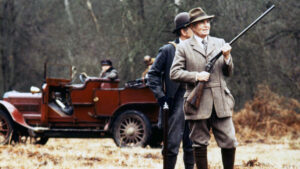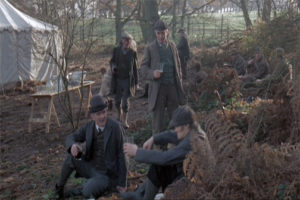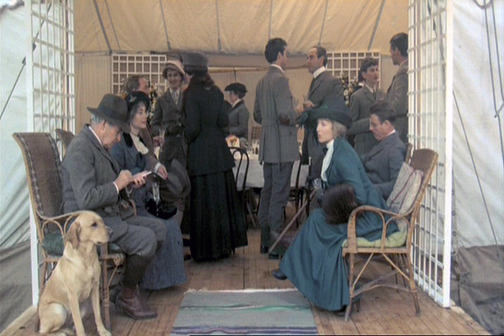Bridges’s hunt picnic is faithful to Isabel Colegate’s gently melancholy novel of English gentry circa 1913, The Shooting Party.
The title The Shooting Party is intended to suggest the larger “shooting party” of the looming world war. Though they know it, Sir Randolph and Minnie Nettleby will be having their last October shooting party and a luncheon before England goes to war in France. 
Because it’s October, the hunt meal will be indoors. Nettleby has the boathouse cleaned, and a fire is lit to ward off the chill. In the center of the room is a long refractory table surrounded by Windsor chairs with damp cushions. The setting reminds one guest of Goldilocks and three bears, but the joke falls flat.
Tragedy occurs after luncheon. Lord Gilbert Hartlip (a nasty man) carelessly shoots a local and kills him when hunting resumes. As the narrative fades, the dead man morphs into a bier with a dead soldier—a solemn ending for a traditional hunt picnic.
Nettleby’s menu is indicative of English social distinctions. For the gentry, prepared and served by staff, there is chicken mayonnaise, Lobster Vol-au-Vents (diced or creamy lobster in a pastry puff), boiled potatoes, lemonade, wine, and iced champagne. But according to Sir Randolph’s largesse, the local men hired to chase the game serve themselves. They sit informally on the turf, eating rabbit stew, baked potatoes, bread, and beer.

Gentry dine at tables, the local men dine on the turf.
The cast: James Mason as Sir Randolph Nettleby; Dorothy Tutin as Lady Minnie Nettleby; Edward Fox as Lord Gilbert Hartlip
See Alan Bridges. The Shooting Party (1984). Screenplay by Julian Bond based on Isabel Colegate’s novel. Isabel Colegate. The Shooting Party. Berkeley, California: Counterpoint, 1980; https://www.youtube.com/watch?v=qBUYXskGylI

